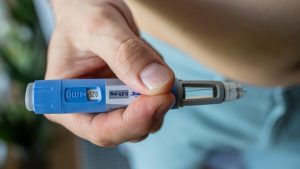Articles / Concerns GLP-1s may reduce oral progesterone absorption

The British Menopause Society (BMS) has released new guidance about potential interactions between GLP-1 receptor agonists, particularly semaglutide and tirzepatide, and oral progestogens women take as part of their Menopause Hormone Therapy (MHT).
The advice comes after Eli Lilly, the producer of tirzepatide (Mounjaro), released data showing that the injection reduces the effectiveness of combined oral contraceptives.
It is thought this may be due to delayed gastric emptying, which occurs with both semaglutide (Ozempic, Wegovy) and tirzepatide.
This has prompted concerns among menopause experts and GPs that both drugs could reduce the effectiveness of oral MHT medications — although so far small studies have not shown that semaglutide impedes absorption of combined oral contraceptives.
Eli Lilly has provided data showing that a single dose of tirzepatide (5 mg) reduced the maximum drug concentration of combined oral contraceptives containing ethinyl estradiol (0.035mg) and norgestimate (0.25mg) by 55-66%. The time to reach peak concentration was increased by 2.5-4.5 hours, and total drug exposure over time of the contraceptive was reduced by 16-23%.
As a result, Eli Lilly recommended that those using combined oral contraceptives change to a non-oral alternative or add a barrier method for the first four weeks after starting tirzepatide, and for four weeks every time the dose is increased.
While little is known about the effect GLP-1 receptor agonists may have on oral progesterone absorption in MHT specifically, the BMS is advising caution.
If a woman has a uterus and is taking oestrogen, progesterone is required for endometrial protection. Hence if progesterone absorption is impeded, this may increase the risk of developing endometrial hyperplasia and in turn, endometrial cancer.
For women taking semaglutide or tirzepatide concomitantly with an oral progestogen, the guidance recommends doctors consider increasing the dose of the progestogen during key periods, switching to a 52mg Levonorgestrel releasing intrauterine device (i.e. Mirena), or changing to an estradiol / norethisterone combination patch. Vaginal use of progesterone capsules is also an option, although this is off-label. It is believed that transdermal or vaginal routes would not be affected by GLP-1s.
The BMS recommends:
“Where oral progestogen is preferred by patients on HRT, there are no data to inform the dose adjustment required for endometrial protection in high-risk women, including those treated with incretin-based therapies. A potential approach is to temporarily increase the dose of oral progestogen for 4 weeks after commencing incretin-based therapies, and with each dose increment. This is based on extrapolation from combined oral contraceptive data and intuitive expert opinion. Uncertainty should be shared with the patient to aid informed decision making,” the BMS guidance states.
Given that increasing and decreasing progestogen doses may not be ideal in practise, they suggest a non-oral route may be an easier and more pragmatic solution.
Professor Rod Baber, gynaecologist and head of the Menopause and Menstrual Disorders Clinic at Royal North Shore Hospital, notes that while switching to a transdermal alternative (e.g. the Estalis patch) is an option, there is no TGA approved transdermal progesterone, and compounded progesterone cream is NOT recommended because “absorption is very unreliable.”
“Perhaps the most sensible approach is to increase the oral dose of progesterone for the first 4 weeks of treatment, after which the risk abates and the usual dose can be used. If the dose of GLP-1 agonist is increased later in the course of treatment, the same rule applies – increase dose for 4 weeks, then back to normal.”
The dose increase remains uncertain, but if using oral progesterone, it would be logical to increase from 100 mg daily to 200 mg daily, as this is convenient and readily accessible, Professor Baber says.
“Alternatives could be Mirena or transvaginal progesterone in the same as oral dose at least 3 times a week or on alternate days,” he adds.
The past decade or so has seen a significant rise in the number of women who are overweight or obese, with the Australian Institute of Health and Welfare estimating that around 60% of Australian women are overweight and 30% of those are obese.
Obesity, diabetes and oral oestrogen all increase the risk of venous thromboembolism (VTE). Transdermal oestrogen is preferred for women using GLP-1 receptor agonists as it has a neutral effect on VTE risk and is unaffected by concomitant oral medications, the BMS’s new guidance explains.
However, it emphasises that the primary consideration “relates to concerns over endometrial protection from potentially reduced absorption of oral progestogens.”
Women who are overweight or obese are already at higher risk of endometrial hyperplasia, cancer and death from endometrial cancer, but losing weight can decrease that risk, they note.
If there is already unscheduled bleeding in women using MHT and GLP-1 RAs, practitioners should follow guidelines for investigation. If bleeding continues after increasing progestogen dose, or if concerned about the clinical presentation or pattern or amount of bleeding, assess to exclude endometrial pathology. The UK-based authors add: “It may be prudent to consider investigations earlier than stated in national guidance in high-risk women (expert opinion).”
Sexual health physician Dr Terri Foran says it’s important for those prescribing incretin-based therapies to advise women of the potential interaction with oral contraceptives or MHT.
“Anything that reduces absorption will increase the risk of failure for those on the lower end of the absorption spectrum as this varies quite a bit from person to person,” she explains.
“We therefore can’t really define a safe individual lower limit since this is derived from trials where a significant number of women achieve an acceptable efficacy, even if it fails a small number,” Dr Foran says.
Mounjaro’s manufacturer advises women taking oral contraceptives to switch to a non-oral alternative or add a barrier method for the first four weeks after starting tirzepatide, and for four weeks every time the dose is increased. The UK’s Faculty of Sexual and Reproductive Healthcare (FSRH) issued recommendations earlier this year, echoing this advice.
“Tirzepatide is the only GLP-1 agonist found to have a clinically significant effect on the bioavailability of oral contraceptives. No clinically relevant reduction in bioavailability of oral contraceptives has been observed with semaglutide, exenatide, liraglutide, dulaglutide or lixisenatide,” the FSRH guidance states.
Based on this educational activity, complete these learning modules to gain additional CPD.

Menopausal Hormone Therapy - What Dose of Estrogen is Best?

Cardiovascular Benefits of GLP1s – New Evidence

Oral Contraceptive Pill in Teens

RSV and the Heart

Modified but kept in place
Eliminated entirely without replacement
Maintained as is
Completely replaced with an alternative system
Listen to expert interviews.
Click to open in a new tab
Browse the latest articles from Healthed.
Once you confirm you’ve read this article you can complete a Patient Case Review to earn 0.5 hours CPD in the Reviewing Performance (RP) category.
Select ‘Confirm & learn‘ when you have read this article in its entirety and you will be taken to begin your Patient Case Review.
Menopause and MHT
Multiple sclerosis vs antibody disease
Using SGLT2 to reduce cardiovascular death in T2D
Peripheral arterial disease
